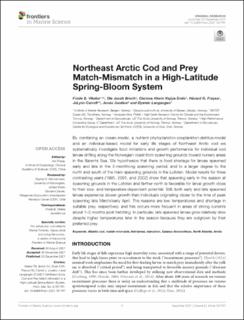| dc.contributor.author | Vikebø, Frode Bendiksen | |
| dc.contributor.author | Broch, Ole Jacob | |
| dc.contributor.author | Kajiya Endo, Clarissa Akemi | |
| dc.contributor.author | Frøysa, Håvard G | |
| dc.contributor.author | Carroll, JoLynn | |
| dc.contributor.author | Juselius, Jonas | |
| dc.contributor.author | Langangen, Øystein Ole Gahr | |
| dc.date.accessioned | 2022-01-28T12:33:59Z | |
| dc.date.available | 2022-01-28T12:33:59Z | |
| dc.date.created | 2022-01-12T13:24:26Z | |
| dc.date.issued | 2021 | |
| dc.identifier.citation | Frontiers in Marine Science. 2021, 8 1-13. | en_US |
| dc.identifier.issn | 2296-7745 | |
| dc.identifier.uri | https://hdl.handle.net/11250/2938717 | |
| dc.description.abstract | By combining an ocean model, a nutrient-phytoplankton-zooplankton-detritus-model and an individual-based model for early life stages of Northeast Arctic cod we systematically investigate food limitations and growth performance for individual cod larvae drifting along the Norwegian coast from spawning grounds toward nursery areas in the Barents Sea. We hypothesize that there is food shortage for larvae spawned early and late in the 2-monthlong spawning period, and to a larger degree to the north and south of the main spawning grounds in the Lofoten. Model results for three contrasting years (1995, 2001, and 2002) show that spawning early in the season at spawning grounds in the Lofoten and farther north is favorable for larval growth close to their size- and temperature-dependent potential. Still, both early and late spawned larvae experience slower growth than individuals originating closer to the time of peak spawning late March/early April. The reasons are low temperatures and shortage in suitable prey, respectively, and this occurs more frequent in areas of strong currents about 1–2 months post hatching. In particular, late spawned larvae grow relatively slow despite higher temperatures later in the season because they are outgrown by their preferred prey. | en_US |
| dc.language.iso | eng | en_US |
| dc.title | Northeast Arctic Cod and Prey Match-Mismatch in a High-Latitude Spring-Bloom System | en_US |
| dc.type | Peer reviewed | en_US |
| dc.type | Journal article | en_US |
| dc.description.version | publishedVersion | en_US |
| dc.source.pagenumber | 1-13 | en_US |
| dc.source.volume | 8 | en_US |
| dc.source.journal | Frontiers in Marine Science | en_US |
| dc.identifier.doi | 10.3389/fmars.2021.767191 | |
| dc.identifier.cristin | 1979450 | |
| dc.relation.project | Notur/NorStore: NS9295K | en_US |
| dc.relation.project | Notur/NorStore: NN9295K | en_US |
| dc.relation.project | Norges forskningsråd: 228107 | en_US |
| dc.relation.project | Norges forskningsråd: 255487 | en_US |
| cristin.ispublished | true | |
| cristin.fulltext | original | |
| cristin.fulltext | original | |
| cristin.qualitycode | 1 | |

